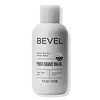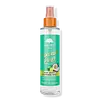What's inside
What's inside
 Key Ingredients
Key Ingredients

No key ingredients
 Benefits
Benefits

 Concerns
Concerns

 Ingredients Side-by-side
Ingredients Side-by-side

Water
Skin ConditioningButylene Glycol
HumectantSorbitol
HumectantButyrospermum Parkii Butter
Skin ConditioningGlyceryl Stearate
EmollientPEG-100 Stearate
Glycerin
HumectantLactic Acid
BufferingPanthenol
Skin ConditioningMenthol
MaskingSalicylic Acid
MaskingNiacinamide
SmoothingSodium Ascorbyl Phosphate
AntioxidantAloe Barbadensis Leaf Juice Powder
Skin ConditioningDipotassium Glycyrrhizate
HumectantAllantoin
Skin ConditioningArgania Spinosa Kernel Oil
EmollientMelaleuca Alternifolia Leaf Oil
AntioxidantTocopheryl Acetate
AntioxidantSimmondsia Chinensis Seed Oil
EmollientDimethicone
EmollientBisabolol
MaskingHamamelis Virginiana Bark/Leaf/Twig Extract
Skin ConditioningHelianthus Annuus Seed Oil
EmollientCarthamus Tinctorius Seed Oil
MaskingCalendula Officinalis Flower Extract
MaskingAvena Sativa Kernel Extract
AbrasiveVitis Vinifera Seed Extract
AntimicrobialPortulaca Oleracea Extract
Skin ConditioningPolysorbate 20
EmulsifyingCetyl Alcohol
EmollientLaureth-4
EmulsifyingStearic Acid
CleansingPolyacrylamide
C13-14 Isoparaffin
EmollientLaureth-7
EmulsifyingCaprylyl Glycol
EmollientPhenoxyethanol
PreservativeXanthan Gum
EmulsifyingTriethanolamine
BufferingParfum
MaskingWater, Butylene Glycol, Sorbitol, Butyrospermum Parkii Butter, Glyceryl Stearate, PEG-100 Stearate, Glycerin, Lactic Acid, Panthenol, Menthol, Salicylic Acid, Niacinamide, Sodium Ascorbyl Phosphate, Aloe Barbadensis Leaf Juice Powder, Dipotassium Glycyrrhizate, Allantoin, Argania Spinosa Kernel Oil, Melaleuca Alternifolia Leaf Oil, Tocopheryl Acetate, Simmondsia Chinensis Seed Oil, Dimethicone, Bisabolol, Hamamelis Virginiana Bark/Leaf/Twig Extract, Helianthus Annuus Seed Oil, Carthamus Tinctorius Seed Oil, Calendula Officinalis Flower Extract, Avena Sativa Kernel Extract, Vitis Vinifera Seed Extract, Portulaca Oleracea Extract, Polysorbate 20, Cetyl Alcohol, Laureth-4, Stearic Acid, Polyacrylamide, C13-14 Isoparaffin, Laureth-7, Caprylyl Glycol, Phenoxyethanol, Xanthan Gum, Triethanolamine, Parfum
Water
Skin ConditioningGlycerin
HumectantSd Alcohol 40-B
AstringentPEG-40 Hydrogenated Castor Oil
EmulsifyingPolysorbate 20
EmulsifyingPropylene Glycol
HumectantParfum
MaskingPanthenol
Skin ConditioningMenthyl Lactate
MaskingCocos Nucifera Oil
MaskingCitrus Aurantifolia Fruit Extract
Skin ConditioningBisabolol
MaskingZingiber Officinale Root Extract
MaskingAloe Barbadensis Leaf Juice
Skin ConditioningAllantoin
Skin ConditioningCarthamus Tinctorius Seed Oil
MaskingCaprylyl Glycol
EmollientEthylhexylglycerin
Skin ConditioningPhenoxyethanol
PreservativeDisodium EDTA
Water, Glycerin, Sd Alcohol 40-B, PEG-40 Hydrogenated Castor Oil, Polysorbate 20, Propylene Glycol, Parfum, Panthenol, Menthyl Lactate, Cocos Nucifera Oil, Citrus Aurantifolia Fruit Extract, Bisabolol, Zingiber Officinale Root Extract, Aloe Barbadensis Leaf Juice, Allantoin, Carthamus Tinctorius Seed Oil, Caprylyl Glycol, Ethylhexylglycerin, Phenoxyethanol, Disodium EDTA
 Reviews
Reviews

Ingredients Explained
These ingredients are found in both products.
Ingredients higher up in an ingredient list are typically present in a larger amount.
Allantoin is a soothing ingredient known for its protective and moisturizingg properties. Because of this, it is often added to products with strong active ingredients.
Studies show higher concentrations of this ingredient can promote wound healing.
Though it can be derived from the comfrey plant, allantoin is produced synthetically for cosmetic products to ensure purity.
Learn more about AllantoinBisabolol is famous for its skin soothing properties. It does this by blocking inflammatory signals, helping to reduce your body's reaction to irritation.
This ingredient also interferes with the process of hyperpigmentation. This can help with reducing dark spots and uneven tone.
Bisabolol is an antioxidant. Antioxidants help fight free-radicals. Free-radicals are molecules that may damage your skin cells. By fighting these free-radicals, Bisabolol may slow down signs of aging.
Studies have shown Bisabolol to have antimicrobial properties and may be a fungicide. These properties help preserve a product's shelf life.
All these properties makes bisabolol a great skin barrier helper ingredient.
Bisabolol also helps the absorption of other ingredients.
Note: Synthetic Bisabolol has been shown to be less effective.
Learn more about BisabololCaprylyl Glycol is a humectant and emollient, meaning it attracts and preserves moisture.
It is a common ingredient in many products, especially those designed to hydrate skin. The primary benefits are retaining moisture, skin softening, and promoting a healthy skin barrier.
Though Caprylyl Glycol is an alcohol derived from fatty acids, it is not the kind that can dry out skin.
This ingredient is also used as a preservative to extend the life of products. It has slight antimicrobial properties.
Learn more about Caprylyl GlycolCarthamus tinctorius seed oil comes from safflower, one of humanity's oldest crops.
Safflower seed oil contains a high percentage of linoleic acid and oleic acid. It also contains Vitamin E. These three components are effective moisturizers.
Vitamin E helps nourish your skin's lipid barrier. It is also a potent antioxidant. Antioxidants help fight free-radical molecules, or unstable molecules that may damage your skin cells.
Due to its high fatty acid content, this ingredient may not be malassezia folliculitis safe.
Thoughout history, safflower has been used for dying fabrics and in food as a saffron substitute.
Learn more about Carthamus Tinctorius Seed OilGlycerin is already naturally found in your skin. It helps moisturize and protect your skin.
A study from 2016 found glycerin to be more effective as a humectant than AHAs and hyaluronic acid.
As a humectant, it helps the skin stay hydrated by pulling moisture to your skin. The low molecular weight of glycerin allows it to pull moisture into the deeper layers of your skin.
Hydrated skin improves your skin barrier; Your skin barrier helps protect against irritants and bacteria.
Glycerin has also been found to have antimicrobial and antiviral properties. Due to these properties, glycerin is often used in wound and burn treatments.
In cosmetics, glycerin is usually derived from plants such as soybean or palm. However, it can also be sourced from animals, such as tallow or animal fat.
This ingredient is organic, colorless, odorless, and non-toxic.
Glycerin is the name for this ingredient in American English. British English uses Glycerol/Glycerine.
Learn more about GlycerinPanthenol is a common ingredient that helps hydrate and soothe the skin. It is found naturally in our skin and hair.
There are two forms of panthenol: D and L.
D-panthenol is also known as dexpanthenol. Most cosmetics use dexpanthenol or a mixture of D and L-panthenol.
Panthenol is famous due to its ability to go deeper into the skin's layers. Using this ingredient has numerous pros (and no cons):
Like hyaluronic acid, panthenol is a humectant. Humectants are able to bind and hold large amounts of water to keep skin hydrated.
This ingredient works well for wound healing. It works by increasing tissue in the wound and helps close open wounds.
Once oxidized, panthenol converts to pantothenic acid. Panthothenic acid is found in all living cells.
This ingredient is also referred to as pro-vitamin B5.
Learn more about PanthenolParfum is a catch-all term for an ingredient or more that is used to give a scent to products.
Also called "fragrance", this ingredient can be a blend of hundreds of chemicals or plant oils. This means every product with "fragrance" or "parfum" in the ingredients list is a different mixture.
For instance, Habanolide is a proprietary trade name for a specific aroma chemical. When used as a fragrance ingredient in cosmetics, most aroma chemicals fall under the broad labeling category of “FRAGRANCE” or “PARFUM” according to EU and US regulations.
The term 'parfum' or 'fragrance' is not regulated in many countries. In many cases, it is up to the brand to define this term.
For instance, many brands choose to label themselves as "fragrance-free" because they are not using synthetic fragrances. However, their products may still contain ingredients such as essential oils that are considered a fragrance by INCI standards.
One example is Calendula flower extract. Calendula is an essential oil that still imparts a scent or 'fragrance'.
Depending on the blend, the ingredients in the mixture can cause allergies and sensitivities on the skin. Some ingredients that are known EU allergens include linalool and citronellol.
Parfum can also be used to mask or cover an unpleasant scent.
The bottom line is: not all fragrances/parfum/ingredients are created equally. If you are worried about fragrances, we recommend taking a closer look at an ingredient. And of course, we always recommend speaking with a professional.
Learn more about ParfumPhenoxyethanol is a preservative that has germicide, antimicrobial, and aromatic properties. Studies show that phenoxyethanol can prevent microbial growth. By itself, it has a scent that is similar to that of a rose.
It's often used in formulations along with Caprylyl Glycol to preserve the shelf life of products.
Polysorbate 20 is made by combining ethoxylation of sorbitan, ethylene oxide, and lauric acid. It is a mild cleansing agent, surfactant, and emulsifier.
As a surfactant, it helps collect dirt and oils for washing. Emulsifiers prevent oils and water from separating.
Polysorbate 20 also adds scent to a product. Since it is made using sorbitol, it has a sweet scent. Sorbitol can also be found in fruits such as apples and peaches.
The lauric acid used to create Polysorbate 20 is often derived from coconuts.
Polysorbate 20 may not be fungal acne safe.
Learn more about Polysorbate 20Water. It's the most common cosmetic ingredient of all. You'll usually see it at the top of ingredient lists, meaning that it makes up the largest part of the product.
So why is it so popular? Water most often acts as a solvent - this means that it helps dissolve other ingredients into the formulation.
You'll also recognize water as that liquid we all need to stay alive. If you see this, drink a glass of water. Stay hydrated!
Learn more about Water